| |
| | |
|
|
Intelligent Internet Services
How to create intelligent media services on the Internet?
|
| | |
 Ubiquitous Computing Ubiquitous Computing
 Ubiquitous Media Ubiquitous Media
 Hybrary - Hybrid Library Hybrary - Hybrid Library
 Museum Technology Museum Technology
 Pervasive Gaming Pervasive Gaming
 Color Quantization Color Quantization
 Image Compression Image Compression
 Quality of Service Quality of Service
Intelligent Internet Services
 Seamless Media Adaptation Seamless Media Adaptation
 Supervised Theses Supervised Theses

|
One of the major driving forces for IP-Telephony is the availability of new enhanced services
instead of just pure Voice over IP. Most of the standardization efforts at the project time
focused on inter-working functionality, developing carrier grade telephony gateways between
IP and traditional telephone networks. Most often, the opportunity to save money on long
distance calls was given as a motivator.
But in a mid-term perspective, the most significant challenge for the acceptance of Internet Telephony
is the availability of value-added intelligent services, going far beyond the existing telephony
services in the PSTN.
During my work in the Internet Services Group of NEC Heidelberg (1998-2003) I was developing Internet Telephony
applications and Service Infrastructures.
|
| | |

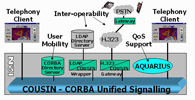
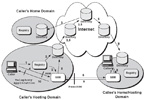
|
I2N
How to combine circuit-switching with packet-switching?
The I2N ("Eye Square N") – Intelligent Internetworking project was realized at the NEC Heidelberg's
Internet Telephony research between 1998-1999.
Inevitably, two formerly separated kinds of communication networks (public switched telephone
networks (PSTN) and packet data communication networks) are meeting under the umbrella of IP telephony.
I2N (Intelligent Internet Telephony) is a novel platform for IP telephony, which takes the best of the network
centric approach of PSTN and the edge centric approach of packet data networks. I2N provides various
layers of a comprehensive IP telephony system, from basic call signalling, via access to user directories
and support of various aspects of mobility, to the rapid integration of value-added services.
Together with the integrated AQUARIUS QoS framework, I2N is perfectly suited to realise user-tailored
communication applications with high quality media support. Interworking with related standards is
provided by multi-level gateway technology.
The platform enables the easy plug-in of new intelligent services within a minimum time-to-market.
It is placed on top of a CORBA object bus, using LDAP Directory Server and is implemented using Java.
Gateways to the H.323 world have been developed, and the platform was introduced at the
ETSI TIPHON TTTnet interoperability project between various H.323 compliant clients, gateways, and gatekeepers.
|
| | |


|
HiTel
How to make a phone call in the Internet?
Since the I2N architecture together with the underlying AQUARIUS QoS framework provides all necessary
signaling and media facilities to realize basic call signaling and voice/video streaming for telephony,
applications using I2N can be built in a very simple way as a stateless collection of GUIs,
either for the active request of a call or as call-back methods for incoming indications.
As a prototype we have developed HiTel (Heidelberg Intelligent Telephony) as a Java application
using Swing components that can also be downloaded from the Web.
This allows for the automatic deployment of new releases.
HiTel can be seen as a virtually user-tailored telephony client, perfectly suited for the demands
of the user without changing one single line of code in the application/applet itself.
HiTel provides mechanisms to subscribe, configure, maintain, and invoke these services from within the telephony client.
HiTel also provides mechanisms to concatenate chains of services.
This can be regarded as a context-sensitive functionality enabling even inexperienced users to exploit the
complete set of services in a very convenient way.
Details about HiTel and the underlying I2N system can be found in:
|
| | |
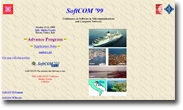

|
Oliver Haase, Andreas Schrader, Kurt Gheis and Rudolph Janz
CORBA Directories for Virtual Home Environments
Proceedings of the IEEE International Conference on Software in Telecommunications and Computer Networks
( SOFTCOM 1999),
Split, Dubrovnik, Croatia; Venice, Italy, October 13-16, 1999. SOFTCOM 1999),
Split, Dubrovnik, Croatia; Venice, Italy, October 13-16, 1999.
|
| | |

|
Oliver Haase, Andreas Schrader, Kurt Gheis and Rudolph Janz
Mobility Support with CORBA Directories
Proceedings of the Communication Networks and Distributed Systems Modeling and Simulation Conference (CNDS'2000),
Society for Modelling & Simulation International
 www.scs.org,
San Diego, CA, USA, January 23-27, 2000. www.scs.org,
San Diego, CA, USA, January 23-27, 2000.
|
| | |


|
Stefan Gessler, Oliver Haase and Andreas Schrader
I2N - A Service Platform for IP Telephony
IP Telephony Workshop, German Informatic Society (GI)
( IPTEL'2000),
Berlin, Germany, April 12-14, 2000. IPTEL'2000),
Berlin, Germany, April 12-14, 2000.
Download  Paper. Paper.
|
| | |

|
Andreas Schrader and Oliver Haase
How V. Cerf and A. Bell would jointly design a Telephony System
Proceedings of the 10th Annual Internet Society Conference
( INET'2000),
Yokohama, Japan, July 18-21, 2000. INET'2000),
Yokohama, Japan, July 18-21, 2000.
Find paper online at
 www.isoc.org
www.isoc.org
|
| | |


|
Stefan Gessler, Oliver Haase and Andreas Schrader
Eine Architektur für Internet Telefonie Dienste
PIK - Praxis der Informationsverarbeitung und Kommunikation
( Special Issue on IP-Telephony),
Vol.24, No.1, pp. 13-17, Jan-Mar 2001. Special Issue on IP-Telephony),
Vol.24, No.1, pp. 13-17, Jan-Mar 2001.
|
| | |


|
MUSE
How to combine service building blocks?
MUSE (Mobile User Service Environment) is a flexible service-provisioning platform
with a special focus on Mobility and Service Composability.
MUSE places at the disposal of users a mobile environment that can be personalized with dynamically
combinable complex services. Service management, multimedia streaming, Quality-of Service, charging,
billing, and security are important functions of this platform. The provisioning of device mobility and
personal mobility enables users to take advantage of their small mobile terminals and to switch
seamlessly to more powerful terminals when needed. Independent of the terminal used, the user will always
be presented with his personal virtual environment, which is defined by his personal service collection
and the session settings depending on the capabilities of the currently used terminal. Dynamic service
composition will enable the user to concatenate services at run-time without explicitly passing the
respective parameters between applications.
This work has been continued at NEC Heidelberg. See
 project page. project page.
Details about MUSE can be found in:
|
| | |


|
Anett Schülke, Andreas Schrader and Oliver Haase
An Architecture for Service Provisioning in Future Networks
Eurescom Summit 3G Technologies and Applications
( EURESCOM'2001),
Heidelberg, Germany, November 13-15, 2001. EURESCOM'2001),
Heidelberg, Germany, November 13-15, 2001.
|
| | |

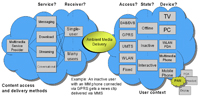
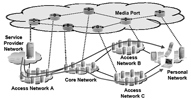
|
Ambient Networks
How to coordinate adaptive media delivery?
My last activity at NEC in 2003 was to organize the set-up of an integrated project (IP) for the
European Commission under the Information Society technology (IST) priority within the 6th Framework Program (FP6)
with a several million Euro budget. The AMBIENT NETWORKS project is part of the Wireless World Initiative (WWI).
As a work package leader I was responsible for the coordinated action of twelve project partners from industry and
academia. The project creates network solutions for mobile and wireless systems beyond 3G.
The objective of the required research was to develop a solution which abstracts network and device heterogeneity
as well as content characteristics in order to create a future proof media distribution architecture,
which allows to easily include new types of content, devices and networks. For this purpose, we introduced distributed
and cooperative MediaPoints for content routing and adaptation.
More information about the AMBIENT NETWORKS project can be found at:
( Wikipedia) Wikipedia)
The first initial ideas of WP 5 (Media) has been presented at the 9th WWRF Workshop in 2003:
|
| | |


|
Andreas Schieder, Uwe Horn and Andreas Schrader
Media Delivery in Future Wireless Networks
9th Wireless World Research Forum (WWRF) Workshop
( WWRF'2003),
WG3, Paper 14, Zurich, Switzerland, July 1-2, 2003. WWRF'2003),
WG3, Paper 14, Zurich, Switzerland, July 1-2, 2003.
|
| | |


|
TuneInNet
How to build up a complete new Internet?
Today's Internet architecture is based on the IP protocol for the transmission of data packets.
Packets will be attached with target and sender addresses in order to guide the routers to decide
the outgoing link on each intermediate network hop.
The TuneInNet project is a cooperation between the Universities of Berlin (FU), Tübingen and Zuerich (Switzerland).
Core idea is to replace routers with simple duplicating entities who send each packet to every connected outgoing link
(flooding). Instead of identifying the receiver by the network itself, we use the very old paradigm of the Internet idea,
which is moving the intelligence to the edge instead of the core. Therefore, in TuneInNet, the receiver can "tune" into
the network at any point and filter his relevant packets itmself. This way, the Internet architecture can be significantly
reduced and at the same time, security can be enhanced by integrating embedded security keys. The scalability of the approach
has been verified by numerous emulations of real networks.
This work is filled for patent.
European Priority File EP20060013176 (June 27, 2006), World Publication Number: WO2008000355, WO2007EP05244 (June 14, 2007), US 2009/196300 A1 (Aug 6, 2009).
Details about TuneInNet have been presented in:
|
| | |

|
Burkhard Stiller: TuneInNet könnte den Datentransfer im Internet vereinfachen
Bulletin, SEV/VSE, 5/2009, May 2009, pp. 13-16, Fehraltorf, Switzerland.
( Download) Download)
|
| | |

|
Paradigmenwechsel im Netz
Computerworld.ch, July 18, 2008.
Bulletin, SEV/VSE, 5/2009, May 2009, pp. 13-16, Fehraltorf, Switzerland.
( Download) Download)
|
| | |

|
Felix Würsten: Revolution im Datennetz
Unimagazin, Die Zeitschrift der Universität Zürich
16. Jahrgang, Nr. 2, May 2007.
( Download) Download)
|
|
|
|